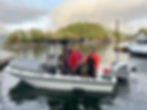2024 USCG Recreational Boating Statistics
- kiley prinz
- Aug 18
- 2 min read

The U.S. Coast Guard’s 2024 Recreational Boating Statistics report was recently released. While it’s full of charts and numbers, it’s also an excellent tool for spotting trends in boating safety. Hidden in the data are insights that can help shape prevention efforts and save lives. This year, there were 556 lives lost in recreational boating incidents. Most were men. Most weren’t wearing life jackets. And most were on boats under 21 feet.
One trend worth paying attention to is that most of our vessel fatalities are occurring in small vessels. Four out of five deaths happened on vessels less than 21 feet. That includes open motorboats, kayaks, canoes, and personal watercraft, the kinds of boats found across the nation, easy to launch and easy to underestimate.
In 2024, 87% of people who drowned weren’t wearing a life jacket. Even among personal watercraft, 85% of the victims weren’t wearing a PFD. People know they should wear one; the disconnect is somewhere else: comfort, culture, or maybe habit. Whatever it is, the data says it’s still costing lives.
And it’s not just crashes. The most deadly initiating event was falling overboard, especially in cold water. In Alaska, the fatality rate was more than ten times the national average at 62.8 deaths per 100,000 registered boats. Of the 20 lives lost in Alaska, only one of the boaters had taken a boating safety course, and 91% weren’t wearing life jackets.
Operator inattention was also a top contributing factor in all incidents, followed closely by inexperience and improper lookout. These are everyday lapses; they aren’t reckless or extreme behaviors. Alcohol use wasn’t the most common cause of accidents, but when alcohol was involved, it was more likely than any other known factor to result in a fatality. It’s a pattern that repeats itself year after year. Saturday is the deadliest day on the water, especially between 2:30 and 6:30 p.m., when people feel relaxed.
This year’s report shows that a lot of accidents happen in good weather and calm water. The stats make it clear that most of these incidents could’ve been prevented. Wearing a life jacket, getting basic training, and making safety part of your routine does make a difference. And sharing real stories isn’t about scaring people, it’s about showing that these are real lives. In the end, safety is about looking out for each other.
Check out the 2024 USCG Recreational Boating Statistics:
